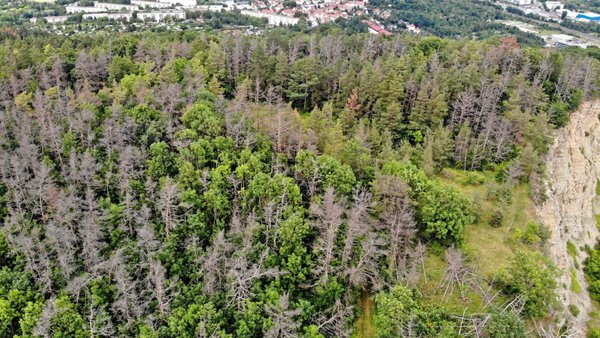Nature: Researchers from Leipzig call for a joint research agenda linking research on climate extremes and biodiversity
Leipzig, 30.11.2022
Press release by iDiv and Leipzig University
Leipzig. The world is experiencing two megatrends: Climate extremes are increasing in magnitude and frequency while biodiversity is declining. Researchers from Leipzig University and the German Centre for Integrative Biodiversity Research (iDiv) with collaborators across Europe, express concern that these two trends can mutually exacerbate each other. Writing in Nature, the researchers call for a new research agenda emphasizing the interconnecting risks of climate extremes and biodiversity decline. Among the authors is Prof. Ina Tegen, who heads the Department of Modelling of Atmospheric Processes at TROPOS and the professorship of the same name at Leipzig University.
To date, awareness is growing that global warming and biodiversity loss are interconnected, even if driven by different mechanisms. If we want to fully understand one of these trends, we should not neglect the other. Consequently, the Intergovernmental Panel on Climate Change (IPCC) and the Intergovernmental Science-Policy Platform on Biodiversity and Ecosystem Services (IPBES) are calling for collaborative approaches to further investigate these interconnected topics.
One of the most salient features of climate changes is that extreme events will increase in intensity and frequency. Writing this week in Nature, a group of researchers from Leipzig University, iDiv and collaborating European institutions expressed particular concern that this specific process will interact with biodiversity decline. In particular, the researchers identified one question that has not yet been investigated at all when they ask whether “... more intense extremes, happening more frequently, accelerate the degradation and uniformization of ecosystems, which then, in turn, promote further climate extremes?” In other words: does the decline of biodiversity add to the magnitude of extremes? If this was true, and there is some evidence for this, a whole new research agenda would have to be developed.
Interdisciplinary approaches are needed
To address this question, interdisciplinary approaches are needed. “Ecologists and climate scientists need to establish a joint scientific vision and agenda, so we are properly forewarned not just of the risks of removing biodiversity buffers against climate extremes, but also of the risk of amplifying extreme events themselves”, the researchers conclude.
The good news is: We do have the necessary methods and tools for data collection and analysis as well as novel measurement techniques, which provide unique insights into plant responses to stress. But this data must be turned into predictions – with the help of high-quality models, digital twins and artificial intelligence methods.
CBD COP 15 should highlight climate and biodiversity linkages
High-level policy is starting to acknowledge the interconnectedness of climate extremes and biodiversity loss, for example by the European Commission’s formal recognition of the multifunctional value of forests and their role in regulating atmospheric processes as well as our climate. A few days ago, new climate policies were adopted at the UNFCC COP27 in Sharm El Sheikh; starting on 7 December, politicians will discuss new biodiversity policies at the CBD COP 15 in Montreal. In their comment in Nature, the researchers stress the need for better linking the research informing policies that target both climate and biodiversity: “Ecologists, climate scientists, remote sensing experts, modellers and data scientists need to work more collaboratively to fill our critical gaps in understanding, in order to thoroughly quantify the risk that lies ahead.”
Kati Kietzmann
Original publication:
Miguel D. Mahecha, Ana Bastos, Friedrich Bohn, Nico Eisenhauer, Hannes Feilhauer, Henrik Hartmann, Thomas Hickler, Heike Kalesse-Los, Mirco Migliavacca, Friederike E.L. Otto, Jian Peng, Johannes Quaas, Ina Tegen, Alexandra Weigelt, Manfred Wendisch, Christian Wirth (2022). Biodiversity loss and climate extremes - study the feedbacks. Nature, DOI
https://www.nature.com/articles/d41586-022-04152-y
Media contacts:
Prof. Dr. Miguel Mahecha
Remote Sensing Centre for Earth System Research
Leipzig University
Helmholtz Centre for Environmental Research - UFZ
German Centre for Integrative Biodiversity Research (iDiv) Halle-Jena-Leipzig
miguel.mahecha[at]uni-leipzig.de
Prof. Dr. Christian Wirth
German Centre for Integrative Biodiversity Research (iDiv) Halle-Jena-Leipzig
Max Planck Fellow at the Max Planck Institute for Biogeochemistry, Jena
Head of the Department for Systematic Botany and Functional Biodiversity at Leipzig University cwirth[at]uni-leipzig.de
Kati Kietzmann
Media & Communications
German Centre for Integrative Biodiversity Research (iDiv) Halle-Jena-Leipzig
kati.kietzmann[at]idiv.de
Further information and links:
Press release of the German Centre for Integrative Biodiversity Research (iDiv) Halle-Jena-Leipzig: https://www.idiv.de/en/news/news_single_view/5027.html
Press release of Leipzig University: https://www.uni-leipzig.de/en/newsdetail/artikel/biodiversity-under-climate-extremes-patient-and-healer-2022-11-30
See also:
Frankfurt Declaration for the UN Biodiversity Conference (COP15) - initiated by the Senckenberg Gesellschaft für Naturforschung and other Leibniz Institutes: https://frankfurter-erklaerung.eu/eng/
The Leibniz Institute for Tropospheric Research (TROPOS) is a member of the Leibniz Association, which connects 97 independent research institutions that range in focus from the natural, engineering and environmental sciences via economics, spatial and social sciences to the humanities. Leibniz Institutes address issues of social, economic and ecological relevance. They conduct knowledge-driven and applied basic research, maintain scientific infrastructure and provide research-based services.
The Leibniz Association identifies focus areas for knowledge transfer to policy-makers, academia, business and the public. Leibniz institutions collaborate intensively with universities – in the form of “Leibniz ScienceCampi” (thematic partnerships between university and non-university research institutes), for example – as well as with industry and other partners at home and abroad.
They are subject to an independent evaluation procedure that is unparalleled in its transparency. Due to the importance of the institutions for the country as a whole, they are funded jointly by the Federation and the Länder, employing some 20,500 individuals, including 11,500 researchers.
The entire budget of all the institutes is approximately 2 billion euros. They are financed jointly by the Federal Government and the Länder. The basic funding of the Leibniz Institute for Tropospheric Research (TROPOS) is therefore financed by the Federal Ministry of Education and Research (BMBF) and the Saxon State Ministry of Science and the Arts (SMWK). The Institute is co-financed with tax revenues on the basis of the budget approved by the Saxon State Parliament.
www.leibniz-gemeinschaft.de/en/home/
www.bmbf.de/en/index.html
https://www.smwk.sachsen.de/

